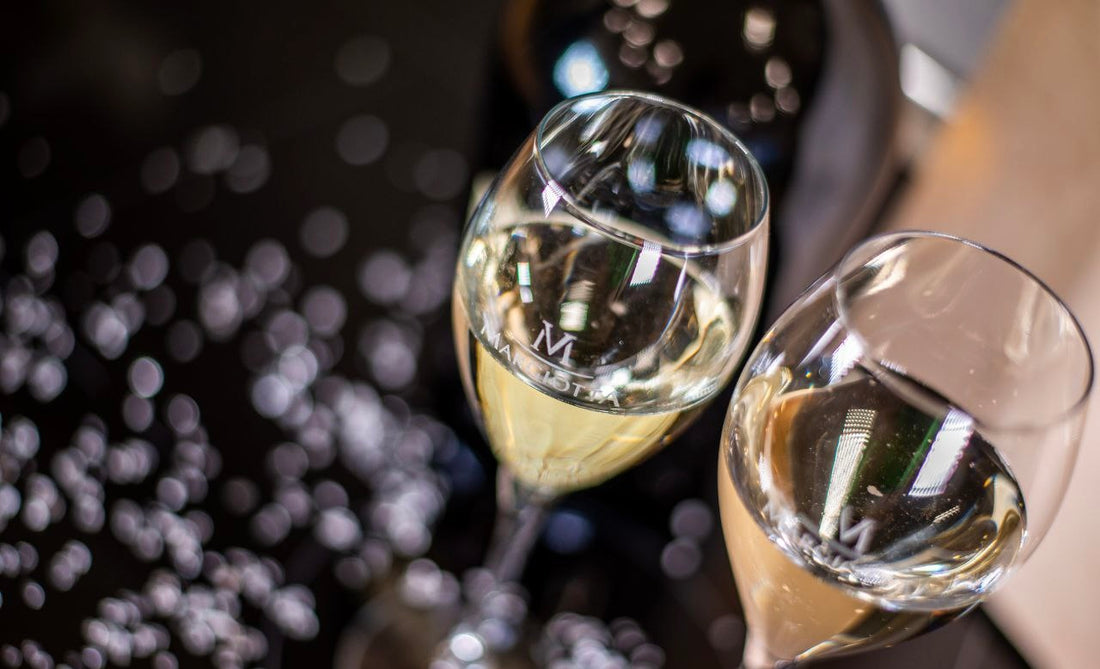
Dry and Sweet Sparkling Wine: A Complete Guide to Differences and Similarities
Sparkling wine, with its lively bubbles, is a wine that always knows how to celebrate an occasion. But not all sparkling wines are the same: the main distinction is between dry and sweet. In this guide, we will explore the characteristics of both, using our Spumante Moscato Dolce "Psitia" as an example of a sweet sparkling wine.
Definition and Classification
Sparkling wines are classified primarily by their residual sugar content. Dry sparkling wines contain between 17 and 32 grams of sugar per liter, while sweet sparkling wines exceed 50 grams per liter. Our "Psitia" falls into the sweet category, offering a pleasant natural sweetness.
Production Process
Both dry and sweet sparkling wines are born from a second fermentation process, which can take place in the bottle (classic method) or in large containers (Charmat method). The main difference is when this fermentation is interrupted:
- For dry sparkling wines, fermentation continues until most of the sugars are converted into alcohol.
- For sweet sparkling wines, like our "Psitia", fermentation is stopped earlier, preserving more of the grapes' natural sugars.
Alcohol Content
Because of this difference in production process, dry sparkling wines tend to have a higher alcohol content, generally between 11% and 12.5%. Sweet sparkling wines, on the other hand, have a lower alcohol content. Our "Psitia", for example, has an alcohol content of 7%, making it a lighter and more refreshing choice.
Organoleptic Profile
The differences in taste and aroma between dry and sweet sparkling wine are notable:
Dry Sparkling Wine:
- Aroma: Notes of fresh fruit, flowers, sometimes hints of yeast or bread crust.
- Taste: Dry, fresh, with pronounced acidity.
- Perlage: Generally fine and persistent.
Sweet Sparkling Wine (like our "Psitia"):
- Aroma: Intense aromas of ripe fruit, sweet flowers, honey.
- Taste: Sweet, but balanced by good acidity.
- Perlage: Usually fine, but less persistent than dry.
Food Pairings
The choice between dry and sweet sparkling wine can significantly influence the gastronomic experience:
Dry Sparkling Wine:
- Ideal as an aperitif
- It pairs well with light appetizers, fish-based first courses, shellfish and seafood.
Sparkling sweet wine:
- Perfect with desserts and pastries
- Excellent with blue cheeses and foie gras
- Our "Psitia" goes wonderfully with a wide range of desserts, from dry pastries to fresh fruit.
Serving Temperature
Serving temperature is crucial to best appreciate the characteristics of each sparkling wine:
- Dry Sparkling Wine: Serve between 6°C and 8°C
- Sweet Sparkling Wine: Slightly colder, between 4°C and 6°C
This temperature difference helps balance the perception of sweetness and maintain freshness.
Versatility in the Kitchen
Both types of sparkling wine can be used creatively in the kitchen:
- Dry sparkling wines are excellent for blending risottos and fish dishes
- Sweet sparkling wines, like our "Psitia", are perfect for desserts, ice creams and sweet marinades for white meats.
Our Sweet Moscato Sparkling Wine "Psitia"
The Spumante Moscato Dolce "Psitia" from the Margiotta Winery represents an excellent example of a sweet sparkling wine:
- Produced with 100% Moscato grapes
- Vinified with the Charmat method to preserve freshness and aromas
- It offers a perfect balance between sweetness and acidity
- Ideal to accompany desserts or as a meditation wine
Conclusion
The choice between dry and sweet sparkling wine depends on personal taste, the occasion and the desired pairing. Both offer a unique and enjoyable experience, each with its own distinctive characteristics. Whether you prefer the liveliness of a dry sparkling wine or the enveloping sweetness of our "Psitia", the world of sparkling wines has something to offer for every palate and every moment.